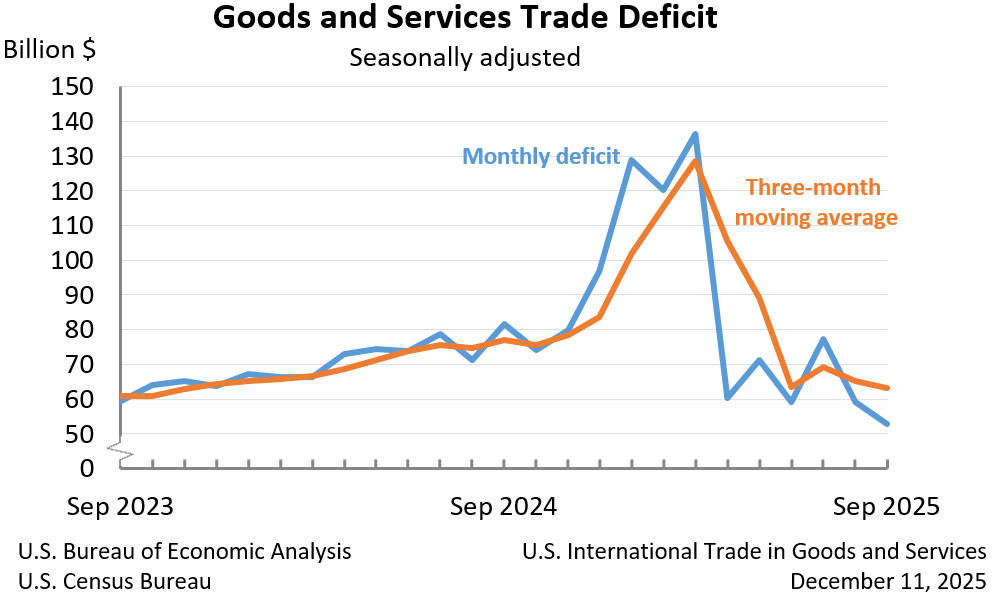Bureau of Economic Analysis
U.S. International Trade in Goods and Services, September 2025
The U.S. goods and services trade deficit decreased in September 2025 according to the U.S. Bureau of Economic Analysis and the U.S. Census Bureau. The deficit decreased from $59.3 billion in August (revised) to $52.8 billion in September, as exports increased more than imports. The goods deficit decreased $7.1 billion in September to $79.0 billion. The services surplus decreased $0.6 billion in September to $26.2 billion.
Principal Federal Economic Indicators
Noteworthy
The Latest
February 2013 Trade Gap is $43.0 Billion
The U.S. monthly international trade deficit decreased in February 2013 according to the U.S. Bureau of Economic Analysis and the U.S. Census Bureau. The deficit decreased from $44.5 billion (revised) in January to $43.0 billion in February as exports increased more than imports. The previously published January deficit was $44.4 billion. The goods deficit decreased $1.5 billion from January to $60.2 billion in February; the services surplus…
Personal Income Increases in February
Personal income increased 1.1 percent in February after decreasing 3.7 percent in January. The January decrease reflected accelerated bonus payments and dividend distributions in December in anticipation of income tax changes.
Personal Income and Outlays, February 2013
Personal income increased $143.2 billion, or 1.1 percent, and disposable personal income (DPI) increased $127.8 billion, or 1.1 percent, in February, according to the Bureau of Economic Analysis. Personal consumption expenditures (PCE) increased $77.2 billion, or 0.7 percent. In January, personal income decreased $513.5 billion, or 3.7 percent, DPI decreased $498.3 billion, or 4.0 percent, and PCE increased $40.8 billion, or 0.4 percent, based…
GDP Growth Slows in Fourth Quarter
Real gross domestic product (GDP) increased 0.4 percent in the fourth quarter of 2013 after increasing 3.1 percent in the third quarter, according to estimates released today by the Bureau of Economic Analysis. The fourth-quarter growth rate was revised up 0.3 percentage point from the second estimate, which was released in February. Final sales, a measure that excludes changes in the volatile inventory component of GDP, increased 1.9…
Gross Domestic Product, 4th quarter and annual 2012 (third estimate); Corporate Profits, 4th quarter and annual 2012
Real gross domestic product -- the output of goods and services produced by labor and property located in the United States -- increased at an annual rate of 0.4 percent in the fourth quarter of 2012 (that is, from the third quarter to the fourth quarter), according to the "third" estimate released by the Bureau of Economic Analysis. In the third quarter, real GDP increased 3.1 percent. The GDP estimate released today is based on…
State Personal Income: Fourth Quarter 2012
In the fourth quarter of 2012, average state personal income growth accelerated to 1.9 percent from 0.6 percent in the third quarter, the fastest pace since the first quarter of 2011. Fourth-quarter growth ranged from 1.3 percent in West Virginia to 4.8 percent in South Dakota. The inflation rate was 0.4 percent in the fourth quarter of 2012, the same as in the third quarter.
For more on state personal income, see the full report…
State Quarterly Personal Income, 1st quarter 2012-4th quarter 2012 and State Annual Personal Income, 2012 (preliminary estimates)
WASHINGTON DC, March 27, 2013 - Average state personal income growth slowed to 3.5 percent in 2012 from 5.2 percent in 2011, according to estimates released today by the U.S. Bureau of Economic Analysis. State personal income growth ranged from -0.2 percent in South Dakota to 12.4 percent in North Dakota. Inflation, as measured by the national price index for personal consumption expenditures, fell to 1.8 percent in 2012 from 2.4 percent in…
Fourth Quarter 2012 U.S. Net International Investment Position
The U.S. net international investment position was –$4,416.2 billion (preliminary) at the end of the fourth quarter of 2012 compared with –$4,663.4 billion at the end of the third quarter as the value of foreign investments in the United States exceeded the value of U.S. investments abroad.
U.S. International Investment Position, 4th quarter and year 2012
Newly-Available Statistics
In this release, BEA introduces new U.S. international investment position statistics on a quarterly basis. The new statistics are available for the fourth quarter of 2005 through the fourth quarter of 2012. Previously-published yearend positions are not revised.




